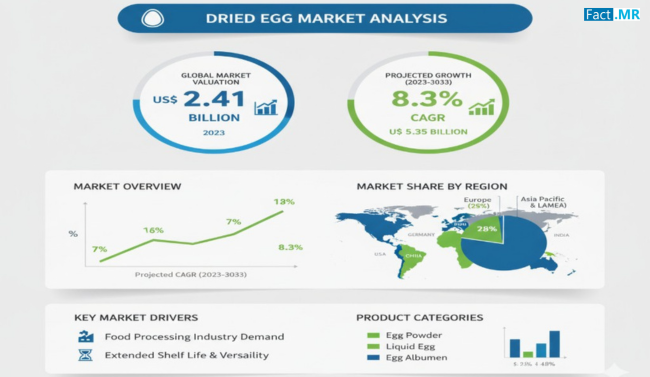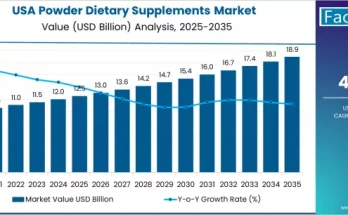The global dried egg market is gaining significant traction as consumers and businesses increasingly recognize its benefits over fresh eggs. Dried eggs, obtained by dehydrating whole eggs, egg whites, or yolks through processes like spray drying or vacuum drying, offer extended shelf life, convenient storage, and ease of use. As lifestyles become busier and the food industry demands more versatile ingredients, dried eggs are emerging as a staple in both commercial kitchens and households.
Market Overview:
Dried eggs are versatile products used in baking, confectionery, and processed foods. Their high protein content, long shelf life, and compact storage requirements make them ideal for food service providers, industrial food processors, and households. Additionally, the product is highly digestible and cost-effective, which has contributed to its increasing adoption globally. Beyond convenience, dried eggs also provide a reliable alternative in regions where refrigeration is limited or inconsistent.
Key Trends:
One prominent trend is the growing use of dried egg whites. Egg whites are highly valued in commercial and domestic cooking due to their functional properties, such as foaming and gelling, which improve food texture and quality. Advances in drying technologies, including freeze-drying and hot air drying, ensure that the nutritional and functional qualities of egg whites are preserved, making them an attractive choice for manufacturers and consumers alike.
Another trend shaping the market is the surge in protein-rich diets. With health-conscious consumers seeking convenient, high-protein options, dried eggs fit perfectly into meal planning, protein supplementation, and fitness regimes. Furthermore, the expansion of the food processing and food service sectors is driving the use of dried eggs in large-scale applications, from bakery mixes to ready-to-eat meals.
Regional Insights:
In the United States, dried eggs are increasingly popular due to rising health and fitness awareness, high demand for protein-rich foods, and the expanding food service industry. The convenience, affordability, and shelf stability of dried eggs make them a favored choice for households and commercial buyers alike.
Europe, particularly Germany, the United Kingdom, and France, is witnessing rising dried egg consumption. European consumers often prefer dried eggs due to strict food safety standards and concerns over bacterial contamination in fresh eggs. Additionally, outbreaks of avian influenza have driven demand for dried eggs, which offer a safe and long-lasting alternative.
Japan also presents significant opportunities for dried egg suppliers. Consumer preference for dried eggs over fresh eggs, primarily due to disease prevention and safety considerations, has fueled consistent growth. Japan’s reliance on imports of dried egg components, including whites and yolks, makes it an attractive market for both domestic and international producers.
Product Insights:
Among product types, dried egg whites are projected to experience the highest demand. Their protein content, functional properties, and versatility in food applications make them particularly attractive for commercial use. Whole dried eggs and yolks also hold steady demand, especially in baking and confectionery applications, where balanced flavor and texture are critical. Manufacturers continue to innovate, improving product quality and expanding applications in various segments, including fortified foods and health supplements.
Challenges in the Market:
Despite its growth, the dried egg market faces certain challenges. The high cost of drying processes and specialized equipment can increase production expenses, affecting pricing and competitive positioning. Supply chain fluctuations, particularly due to seasonal variations or disease outbreaks among poultry, can disrupt consistent production. Additionally, the rise of vegan and plant-based diets poses long-term challenges, as alternative protein sources and egg substitutes gain popularity.
Opportunities for Innovation:
Opportunities abound for companies in the dried egg market to innovate. Product diversification, such as fortified egg powders or functional blends, can cater to niche markets like fitness enthusiasts or clinical nutrition. Technological advancements in drying techniques can enhance nutritional retention, flavor, and solubility, improving consumer acceptance. Companies can also explore sustainable and ethically sourced products, aligning with growing consumer preference for clean-label and environmentally conscious options.
Conclusion:
The dried egg market represents a dynamic and evolving segment within the global food industry. Rising demand for convenience, protein-rich diets, and functional food ingredients, coupled with expanding commercial and household applications, positions dried eggs as a key component of modern nutrition. By navigating challenges such as production costs, supply chain stability, and competition from plant-based alternatives, manufacturers can capitalize on the growing opportunities in this market. With continued innovation and consumer education, dried eggs are poised to remain a vital ingredient for both health-conscious consumers and industrial food applications in the years ahead.
Takeaway:
For producers, retailers, and food service providers, understanding regional demand, product trends, and consumer preferences is essential to succeed in the dried egg market. Offering versatile, high-quality, and convenient products can help meet evolving dietary habits while supporting global food security and nutrition goals.



